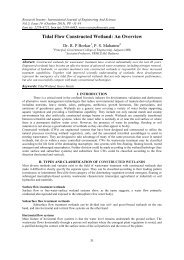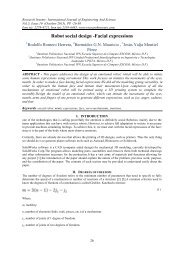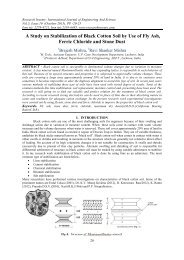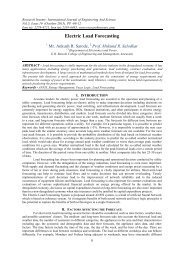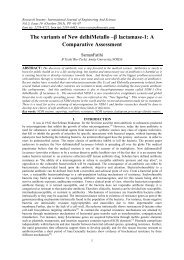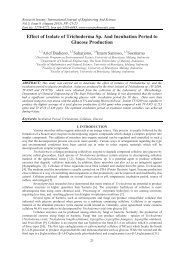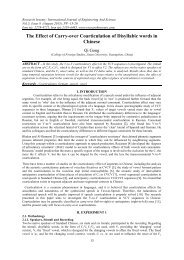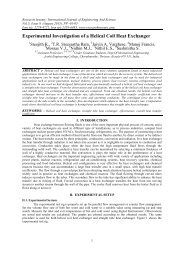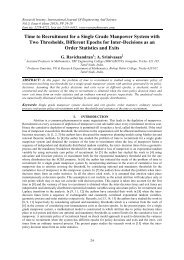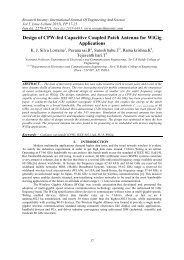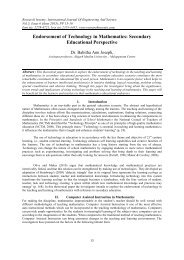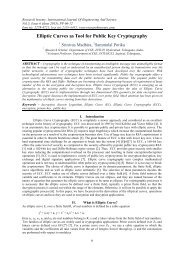The Impact of Employment Progression on Students Towards Higher Education
Create successful ePaper yourself
Turn your PDF publications into a flip-book with our unique Google optimized e-Paper software.
Research Inventy: Internati<strong>on</strong>al Journal Of Engineering And Science<br />
Vol.5, Issue 6 (June 2015), PP 01-05<br />
Issn (e): 2278-4721, Issn (p):2319-6483, www.researchinventy.com<br />
<str<strong>on</strong>g>The</str<strong>on</strong>g> <str<strong>on</strong>g>Impact</str<strong>on</strong>g> <str<strong>on</strong>g>of</str<strong>on</strong>g> <str<strong>on</strong>g>Employment</str<strong>on</strong>g> <str<strong>on</strong>g>Progressi<strong>on</strong></str<strong>on</strong>g> <strong>on</strong> <strong>Students</strong><br />
<strong>Towards</strong> <strong>Higher</strong> Educati<strong>on</strong><br />
V.Maheswari 1 and R.Haridas 2<br />
1 Research Scholar, Department <str<strong>on</strong>g>of</str<strong>on</strong>g> Management Studies, Karpagam University, Coimbatore, Tamilnadu, India<br />
2 Assistant Pr<str<strong>on</strong>g>of</str<strong>on</strong>g>essor, Department <str<strong>on</strong>g>of</str<strong>on</strong>g> Business Administrati<strong>on</strong>, Government Arts College (Aut<strong>on</strong>omous), Salem,<br />
Tamilnadu, India.<br />
ABSTRACT : <str<strong>on</strong>g>The</str<strong>on</strong>g> aim <str<strong>on</strong>g>of</str<strong>on</strong>g> this study is to describe the impact <str<strong>on</strong>g>of</str<strong>on</strong>g> employment progressi<strong>on</strong> towards higher<br />
educati<strong>on</strong>. This study is based <strong>on</strong> previous studies which had looked into the involvement between the<br />
employment sequence and higher educati<strong>on</strong> sector. About 625 questi<strong>on</strong>naires had been distributed to under<br />
graduate students in arts and science colleges in Coimbatore district. <str<strong>on</strong>g>The</str<strong>on</strong>g> collected data were analyzed using<br />
SPSS s<str<strong>on</strong>g>of</str<strong>on</strong>g>tware. <str<strong>on</strong>g>The</str<strong>on</strong>g> analysis showed that there is a significant relati<strong>on</strong>ship between the pers<strong>on</strong>al variables and<br />
employment progressi<strong>on</strong> <str<strong>on</strong>g>of</str<strong>on</strong>g> the resp<strong>on</strong>dents. Results <str<strong>on</strong>g>of</str<strong>on</strong>g> this study dem<strong>on</strong>strate that the students drift from the<br />
under graduati<strong>on</strong> to post graduati<strong>on</strong> for the purpose <str<strong>on</strong>g>of</str<strong>on</strong>g> employment opportunities.<br />
Key words: <strong>Students</strong>, <str<strong>on</strong>g>Employment</str<strong>on</strong>g> progressi<strong>on</strong>, <strong>Higher</strong> educati<strong>on</strong><br />
I. INTRODUCTION<br />
Social and Ec<strong>on</strong>omic background emerged out as an important factor in the students’ desire toward<br />
higher educati<strong>on</strong>. <str<strong>on</strong>g>The</str<strong>on</strong>g>ir interest in higher educati<strong>on</strong> may be unenthusiastic because <str<strong>on</strong>g>of</str<strong>on</strong>g> social, cultural and<br />
ec<strong>on</strong>omic barriers. <strong>Higher</strong> educati<strong>on</strong> provides opportunities for lifel<strong>on</strong>g learning, allowing people to upgrade<br />
their knowledge and skills from time to time based <strong>on</strong> societal needs. <str<strong>on</strong>g>The</str<strong>on</strong>g> University Grants Commissi<strong>on</strong><br />
(UGC), All India Council for Technical Educati<strong>on</strong> (AICTE), Distance Educati<strong>on</strong> Council (DEC), Indian<br />
Council for Agriculture Research (ICAR), Bar Council <str<strong>on</strong>g>of</str<strong>on</strong>g> India (BCI), Nati<strong>on</strong>al Council for Teacher Educati<strong>on</strong><br />
(NCTE), Nati<strong>on</strong>al Council <str<strong>on</strong>g>of</str<strong>on</strong>g> Educati<strong>on</strong>al Research and Training (NCERT) and such other regulatory bodies<br />
from time to time accommodate the developments and yet maintain quality students in higher educati<strong>on</strong>. <str<strong>on</strong>g>The</str<strong>on</strong>g><br />
12 th Five year plan focuses <strong>on</strong> utilizing the opportunity <str<strong>on</strong>g>of</str<strong>on</strong>g> expansi<strong>on</strong> for deepening excellence and achieving<br />
equal access to quality higher educati<strong>on</strong>. A target <str<strong>on</strong>g>of</str<strong>on</strong>g> 30 percent Gross Enrollment Ratio (GER) by 2017 from 15<br />
percent in 2012 is set for the 12 th five year plan.<br />
<str<strong>on</strong>g>The</str<strong>on</strong>g>re is always a disparity between higher educati<strong>on</strong> and job openings. It is seen that many graduates<br />
in India tend to accept lower paid jobs which are incompatible with their qualificati<strong>on</strong>s. Currently 14.6 milli<strong>on</strong><br />
(86%) students are enrolled in under graduate courses compared to 2 milli<strong>on</strong> (12%) in post graduate courses 1 . In<br />
September 2014, making their first bilateral summit, Indian Prime Minister Mr.Narendra Modi and American<br />
President Mr.Barack Obama committed the strategic partnership between the two countries, to serve as a guide<br />
to boost cooperati<strong>on</strong> between the two countries in various sectors, including higher educati<strong>on</strong> and improve<br />
employment opportunities, over the next decade. <str<strong>on</strong>g>The</str<strong>on</strong>g> Government has launched new educati<strong>on</strong> scheme named<br />
as Madan Mohan Malaviya Nati<strong>on</strong>al Missi<strong>on</strong> <strong>on</strong> Teachers and Teaching in December 2014 for the purpose <str<strong>on</strong>g>of</str<strong>on</strong>g><br />
improving educati<strong>on</strong> sector. Parental involvement was directly associated with students aspirati<strong>on</strong>s towards<br />
higher educati<strong>on</strong>. It is found that under graduate students who planned to leave educati<strong>on</strong> where mostly from<br />
agriculture based and middle income level families. Social Identity <str<strong>on</strong>g>The</str<strong>on</strong>g>ory is based <strong>on</strong> the assumpti<strong>on</strong> that part<br />
<str<strong>on</strong>g>of</str<strong>on</strong>g> an individual’s self-c<strong>on</strong>cept comes from the groups to which he or she bel<strong>on</strong>gs to. <str<strong>on</strong>g>The</str<strong>on</strong>g>re are a few important<br />
elements like family background, peer influences, own expectati<strong>on</strong>s, own capabilities, individual beliefs that<br />
give some impact <strong>on</strong> the students employment progressi<strong>on</strong> so that they are unable to c<strong>on</strong>tinue their higher<br />
educati<strong>on</strong>.<br />
II. LITERATURE REVIEW<br />
Gautam Chandra Deb (2014) has explained that higher educati<strong>on</strong> is becoming a marketing commodity.<br />
Nati<strong>on</strong>al and global competiti<strong>on</strong> may create problems <str<strong>on</strong>g>of</str<strong>on</strong>g> survival <str<strong>on</strong>g>of</str<strong>on</strong>g> weaker universities and colleges. He<br />
suggested that many colleges and universities were started in India for removing regi<strong>on</strong>al imbalances and<br />
for supporting educati<strong>on</strong> <str<strong>on</strong>g>of</str<strong>on</strong>g> weaker and disadvantaged classes, particularly women. But it is creating<br />
frustrati<strong>on</strong> am<strong>on</strong>g graduates when they find that educati<strong>on</strong> is not so useful in employment and in work<br />
situati<strong>on</strong>s 2 . Powar (2012) argues that the co-relati<strong>on</strong> between higher educati<strong>on</strong> and employment is complex in<br />
the Indian c<strong>on</strong>text as a number <str<strong>on</strong>g>of</str<strong>on</strong>g> socio-ec<strong>on</strong>omic and technological variables are involved. <str<strong>on</strong>g>The</str<strong>on</strong>g> Indian<br />
ec<strong>on</strong>omy boasts unprecedented growth and is <strong>on</strong>e <str<strong>on</strong>g>of</str<strong>on</strong>g> the highest growth rates in the world.<br />
1
2<br />
<str<strong>on</strong>g>The</str<strong>on</strong>g> <str<strong>on</strong>g>Impact</str<strong>on</strong>g> <str<strong>on</strong>g>of</str<strong>on</strong>g> <str<strong>on</strong>g>Employment</str<strong>on</strong>g> <str<strong>on</strong>g>Progressi<strong>on</strong></str<strong>on</strong>g>…<br />
<str<strong>on</strong>g>The</str<strong>on</strong>g> researcher c<strong>on</strong>cluded that there are socio ec<strong>on</strong>omic factors that severely affect the link between<br />
employment and higher educati<strong>on</strong> sector 3 . <str<strong>on</strong>g>The</str<strong>on</strong>g> Bost<strong>on</strong> c<strong>on</strong>sulting group (2010) stated that the employability is<br />
the key for bridging the skills gaps in general and in facilitating migrati<strong>on</strong> <str<strong>on</strong>g>of</str<strong>on</strong>g> the highly skilled in particular, as<br />
employers are suspicious <str<strong>on</strong>g>of</str<strong>on</strong>g> the qualificati<strong>on</strong>s <str<strong>on</strong>g>of</str<strong>on</strong>g> immigrants. <str<strong>on</strong>g>The</str<strong>on</strong>g>re are three main reas<strong>on</strong>s to explain the<br />
relatively low employability <str<strong>on</strong>g>of</str<strong>on</strong>g> many graduates. First, the quality <str<strong>on</strong>g>of</str<strong>on</strong>g> educati<strong>on</strong>al systems, sec<strong>on</strong>d, the<br />
educati<strong>on</strong>al systems do not <str<strong>on</strong>g>of</str<strong>on</strong>g>ten meet the needs <str<strong>on</strong>g>of</str<strong>on</strong>g> ec<strong>on</strong>omies and do not prepare the highly skilled for positi<strong>on</strong>s<br />
with global companies, and third, the skills development cycle is not aligned with the fast-changing market<br />
c<strong>on</strong>diti<strong>on</strong>s. As a result, in developing countries, global companies have difficulties in finding graduate students<br />
who are directly employable 4 . Marie Glenn (2008) said in today’s technology-enabled knowledge ec<strong>on</strong>omy,<br />
many universities find themselves facing a new challenge now not <strong>on</strong>ly to equip students with an adequate<br />
educati<strong>on</strong> in their field <str<strong>on</strong>g>of</str<strong>on</strong>g> study, but also to arm them with the skills and knowledge required to leverage<br />
technology effectively in the workplace 5 . Brown and Hesketh (2004) have shown, that there are still inequalities<br />
am<strong>on</strong>g graduates in their labour market outcomes. <str<strong>on</strong>g>The</str<strong>on</strong>g>y show that many graduates are not utilizing their<br />
knowledge and skills from higher educati<strong>on</strong>, that not all are able to ‘cash in’ <strong>on</strong> their investment in higher<br />
educati<strong>on</strong>, and that there are still positi<strong>on</strong>al differences between graduates <strong>on</strong> the basis <str<strong>on</strong>g>of</str<strong>on</strong>g> social class, gender<br />
and ethnicity 6 . Archer et al (2001) have researched that the higher educati<strong>on</strong> has been seen almost solely as a<br />
route to higher salary. Many have made no c<strong>on</strong>necti<strong>on</strong> between the skills gained <strong>on</strong> a higher educati<strong>on</strong> course 7 .<br />
Much <str<strong>on</strong>g>of</str<strong>on</strong>g> the students research work c<strong>on</strong>ducted have tended to focus <strong>on</strong> either in quality <str<strong>on</strong>g>of</str<strong>on</strong>g> higher educati<strong>on</strong> or<br />
motivati<strong>on</strong> towards higher educati<strong>on</strong>. From the above review <str<strong>on</strong>g>of</str<strong>on</strong>g> the related literature, it may be stated that global<br />
competiti<strong>on</strong>, socio-ec<strong>on</strong>omic and technological changes, skill gap <str<strong>on</strong>g>of</str<strong>on</strong>g> employees, psychological barriers affecting<br />
the employment progressi<strong>on</strong> are investigated related to the field <str<strong>on</strong>g>of</str<strong>on</strong>g> higher educati<strong>on</strong>. <str<strong>on</strong>g>The</str<strong>on</strong>g>re has been very little<br />
recent empirical work exploring the way in which students and graduates are beginning to understand and<br />
manage their employment in the c<strong>on</strong>text <str<strong>on</strong>g>of</str<strong>on</strong>g> recent higher educati<strong>on</strong>. <str<strong>on</strong>g>The</str<strong>on</strong>g> main focus <str<strong>on</strong>g>of</str<strong>on</strong>g> this paper is to study<br />
how students higher educati<strong>on</strong> can influence their employment progress.<br />
III. OBJECTIVES<br />
To identify the associati<strong>on</strong> between students employment progressi<strong>on</strong> and higher educati<strong>on</strong><br />
programmes. To find out the influence <str<strong>on</strong>g>of</str<strong>on</strong>g> student pers<strong>on</strong>al variables <strong>on</strong> the preference <str<strong>on</strong>g>of</str<strong>on</strong>g> higher educati<strong>on</strong>.<br />
IV. METHODOLOGY<br />
<str<strong>on</strong>g>The</str<strong>on</strong>g> resp<strong>on</strong>dents <str<strong>on</strong>g>of</str<strong>on</strong>g> this study comprised under graduate students <str<strong>on</strong>g>of</str<strong>on</strong>g> arts and science colleges in<br />
Coimbatore district. In this study, the researcher has used random sampling method. Questi<strong>on</strong>naire method is<br />
used to obtain the data from the resp<strong>on</strong>dents. Five point Likert type scale facilitated the researcher in<br />
implementing the data collecti<strong>on</strong> and analysis. A total <str<strong>on</strong>g>of</str<strong>on</strong>g> 625 questi<strong>on</strong>naires were distributed to the final year<br />
under graduate students. <str<strong>on</strong>g>The</str<strong>on</strong>g> samples were selected using simple random sampling method to answer the<br />
questi<strong>on</strong>naire. <str<strong>on</strong>g>The</str<strong>on</strong>g> resp<strong>on</strong>dents were selected from different courses, habitat, family background, occupati<strong>on</strong>,<br />
gender and age groups. <str<strong>on</strong>g>The</str<strong>on</strong>g>y were required to answer the questi<strong>on</strong>naire based <strong>on</strong> their study experience. An<br />
Analysis <str<strong>on</strong>g>of</str<strong>on</strong>g> Variance [ANOVA] was c<strong>on</strong>ducted to examine any difference in mean resp<strong>on</strong>ses between the<br />
pers<strong>on</strong>al variables and employee progressi<strong>on</strong>. T-test is also used for independent samples. Multiple regressi<strong>on</strong><br />
was also used to relate the resp<strong>on</strong>dent’s capabilities and beliefs. In this study, the statistical analysis investigates<br />
the resp<strong>on</strong>dent’s pers<strong>on</strong>al variables (like gender, course discipline, first graduate in the family, selecti<strong>on</strong> <str<strong>on</strong>g>of</str<strong>on</strong>g><br />
additi<strong>on</strong>al courses and family background) influencing the employment sequence which affect the under<br />
graduate to post graduate programmes.<br />
V. RESULTS AND DISCUSSION<br />
In this secti<strong>on</strong>, the results <str<strong>on</strong>g>of</str<strong>on</strong>g> multiple regressi<strong>on</strong>s are analyzed between the dependent variable<br />
(pers<strong>on</strong>al variables) and the independent variable as employment progressi<strong>on</strong> <str<strong>on</strong>g>of</str<strong>on</strong>g> the resp<strong>on</strong>dents. <str<strong>on</strong>g>The</str<strong>on</strong>g> results <str<strong>on</strong>g>of</str<strong>on</strong>g><br />
Multiple Regressi<strong>on</strong> Analysis in terms <str<strong>on</strong>g>of</str<strong>on</strong>g> independent variables, coefficient <str<strong>on</strong>g>of</str<strong>on</strong>g> correlati<strong>on</strong> (R), coefficient <str<strong>on</strong>g>of</str<strong>on</strong>g><br />
determinati<strong>on</strong> (R2), incremental value in R2, p – value and its significance are analyzed. One independent<br />
variable is introduced at each stage to assess the incremental values in the value <str<strong>on</strong>g>of</str<strong>on</strong>g> R2, which provide the<br />
percentage <str<strong>on</strong>g>of</str<strong>on</strong>g> explanati<strong>on</strong> <strong>on</strong> the dependent variable.<br />
TABLE - 1<br />
Gender and employment progressi<strong>on</strong> <str<strong>on</strong>g>of</str<strong>on</strong>g> the resp<strong>on</strong>dents<br />
Descripti<strong>on</strong> Gender (%) R R 2 Incremental p-<br />
Significance<br />
value value<br />
<str<strong>on</strong>g>Employment</str<strong>on</strong>g> Male 48<br />
0.088 0.008 0.001 0.565 NS<br />
<str<strong>on</strong>g>Progressi<strong>on</strong></str<strong>on</strong>g> Female 52<br />
(Source: Primary data)
<str<strong>on</strong>g>The</str<strong>on</strong>g> <str<strong>on</strong>g>Impact</str<strong>on</strong>g> <str<strong>on</strong>g>of</str<strong>on</strong>g> <str<strong>on</strong>g>Employment</str<strong>on</strong>g> <str<strong>on</strong>g>Progressi<strong>on</strong></str<strong>on</strong>g>…<br />
In the above table 1, the researcher c<strong>on</strong>sidered gender as dependent variable to relate the resp<strong>on</strong>dent’s<br />
attitude <str<strong>on</strong>g>of</str<strong>on</strong>g> employment progressi<strong>on</strong>. In this study, the researcher used multiple regressi<strong>on</strong> test and got a p-value<br />
<str<strong>on</strong>g>of</str<strong>on</strong>g> 0.565. <str<strong>on</strong>g>The</str<strong>on</strong>g> level <str<strong>on</strong>g>of</str<strong>on</strong>g> significance at 5% and the degree <str<strong>on</strong>g>of</str<strong>on</strong>g> freedom was also calculated. <str<strong>on</strong>g>The</str<strong>on</strong>g> result indicated<br />
that there is no significant influence <strong>on</strong> the dependent variable gender. It is c<strong>on</strong>cluded that majority <str<strong>on</strong>g>of</str<strong>on</strong>g> the<br />
female resp<strong>on</strong>dent’s give more importance to employment opportunities, occupati<strong>on</strong> <str<strong>on</strong>g>of</str<strong>on</strong>g> their family, doing own<br />
business, self-employment, etc. So, they are not interested to c<strong>on</strong>tinue the higher educati<strong>on</strong> programmes.<br />
TABLE - 2<br />
Family occupati<strong>on</strong> and employment progressi<strong>on</strong> <str<strong>on</strong>g>of</str<strong>on</strong>g> the resp<strong>on</strong>dents<br />
Descripti<strong>on</strong> Family Occupati<strong>on</strong> (%) R R 2 Incremental p-<br />
value value<br />
<str<strong>on</strong>g>Employment</str<strong>on</strong>g> 34<br />
<str<strong>on</strong>g>Employment</str<strong>on</strong>g><br />
<str<strong>on</strong>g>Progressi<strong>on</strong></str<strong>on</strong>g><br />
Business 14<br />
Agriculture 37<br />
Self employed 11<br />
Significance<br />
0.092 0.009 0.002 0.506 NS<br />
Pr<str<strong>on</strong>g>of</str<strong>on</strong>g>essi<strong>on</strong>als 4<br />
(Source: Primary data)<br />
<str<strong>on</strong>g>The</str<strong>on</strong>g> above Table no 2 shows that family occupati<strong>on</strong> c<strong>on</strong>sidered as main factor plays a crucial role to the<br />
resp<strong>on</strong>dents employment progressi<strong>on</strong> and unable to c<strong>on</strong>tinue their higher educati<strong>on</strong> programmes. In this table,<br />
the researcher obtained the p-value 0.506 which is calculated using multiple regressi<strong>on</strong>s. <str<strong>on</strong>g>The</str<strong>on</strong>g> level <str<strong>on</strong>g>of</str<strong>on</strong>g><br />
significance at 5% is calculated. Those indicate that the variables, family occupati<strong>on</strong> and employment<br />
progressi<strong>on</strong> did not have significant influence <strong>on</strong> resp<strong>on</strong>dents in the selecti<strong>on</strong> <str<strong>on</strong>g>of</str<strong>on</strong>g> higher studies. Majority <str<strong>on</strong>g>of</str<strong>on</strong>g> the<br />
resp<strong>on</strong>dents came from agricultural based families. Basically, the resp<strong>on</strong>dents are interested to c<strong>on</strong>tinuing their<br />
family business, going to start own business etc., It is c<strong>on</strong>cluded that the resp<strong>on</strong>dents are not interested to<br />
c<strong>on</strong>tinue post-graduati<strong>on</strong> programmes for the purpose <str<strong>on</strong>g>of</str<strong>on</strong>g> their career progressi<strong>on</strong>.<br />
TABLE - 3<br />
First graduati<strong>on</strong> in family and employment progressi<strong>on</strong> <str<strong>on</strong>g>of</str<strong>on</strong>g> the resp<strong>on</strong>dents<br />
Descripti<strong>on</strong><br />
First Graduati<strong>on</strong><br />
R R 2 Incremental p-<br />
(%)<br />
value value<br />
Significance<br />
<str<strong>on</strong>g>Employment</str<strong>on</strong>g> Yes 76<br />
<str<strong>on</strong>g>Progressi<strong>on</strong></str<strong>on</strong>g> No 24<br />
0.102 0.010 0.002 0.373 NS<br />
(Source: Primary data)<br />
Table no 3 represents the first graduate in family and employment progressi<strong>on</strong> <str<strong>on</strong>g>of</str<strong>on</strong>g> the resp<strong>on</strong>dents. In<br />
this study, majority <str<strong>on</strong>g>of</str<strong>on</strong>g> the resp<strong>on</strong>dents are first graduate in family. Using the multiple regressi<strong>on</strong> method, the<br />
researcher finds the p-value as 0.373. <str<strong>on</strong>g>The</str<strong>on</strong>g> level <str<strong>on</strong>g>of</str<strong>on</strong>g> significance at 5% and degrees <str<strong>on</strong>g>of</str<strong>on</strong>g> freedom was also<br />
calculated. <str<strong>on</strong>g>The</str<strong>on</strong>g> above table shows that, first graduati<strong>on</strong> and employment progressi<strong>on</strong>, had statistically no<br />
significant influence to c<strong>on</strong>tinue their higher studies. <str<strong>on</strong>g>The</str<strong>on</strong>g> researcher found that the majority <str<strong>on</strong>g>of</str<strong>on</strong>g> the resp<strong>on</strong>dents<br />
were the first graduate in their family. So the resp<strong>on</strong>dents did not c<strong>on</strong>tinue their post-graduati<strong>on</strong> because <str<strong>on</strong>g>of</str<strong>on</strong>g> lack<br />
<str<strong>on</strong>g>of</str<strong>on</strong>g> support from family and peer influence.<br />
TABLE - 4<br />
Additi<strong>on</strong>al courses and employment progressi<strong>on</strong> <str<strong>on</strong>g>of</str<strong>on</strong>g> the resp<strong>on</strong>dents<br />
Descripti<strong>on</strong><br />
Additi<strong>on</strong>al Courses<br />
R R 2 Incremental p-<br />
(%)<br />
value value<br />
Significance<br />
<str<strong>on</strong>g>Employment</str<strong>on</strong>g> Yes 38<br />
<str<strong>on</strong>g>Progressi<strong>on</strong></str<strong>on</strong>g> No 62<br />
0.154 0.024 0.001 0.021 S<br />
(Source: Primary data)<br />
Table no 4 shows the calculated values <str<strong>on</strong>g>of</str<strong>on</strong>g> multiple regressi<strong>on</strong> in terms <str<strong>on</strong>g>of</str<strong>on</strong>g><br />
coefficient <str<strong>on</strong>g>of</str<strong>on</strong>g> correlati<strong>on</strong> (R), coefficient <str<strong>on</strong>g>of</str<strong>on</strong>g> determinati<strong>on</strong> (R 2 ), incremental value in R 2 and<br />
p–value. <str<strong>on</strong>g>The</str<strong>on</strong>g> level <str<strong>on</strong>g>of</str<strong>on</strong>g> significance at 5% and degree <str<strong>on</strong>g>of</str<strong>on</strong>g> freedom was also calculated. <str<strong>on</strong>g>The</str<strong>on</strong>g> p-value 0.021<br />
represents the variable that has significant influence <strong>on</strong> the dependent variable. This study shows that majority<br />
<str<strong>on</strong>g>of</str<strong>on</strong>g> the resp<strong>on</strong>dents join the additi<strong>on</strong>al courses to catch the job at undergraduate level. <str<strong>on</strong>g>The</str<strong>on</strong>g> researcher found that<br />
the resp<strong>on</strong>dents prefer job with training without higher studies. So they are interested to join the additi<strong>on</strong>al<br />
courses and hence do not to c<strong>on</strong>tinue their post graduate programmes.<br />
3
4<br />
<str<strong>on</strong>g>The</str<strong>on</strong>g> <str<strong>on</strong>g>Impact</str<strong>on</strong>g> <str<strong>on</strong>g>of</str<strong>on</strong>g> <str<strong>on</strong>g>Employment</str<strong>on</strong>g> <str<strong>on</strong>g>Progressi<strong>on</strong></str<strong>on</strong>g>…<br />
TABLE - 5<br />
Discipline and employment progressi<strong>on</strong> <str<strong>on</strong>g>of</str<strong>on</strong>g> the resp<strong>on</strong>dents<br />
Descripti<strong>on</strong><br />
Discipline (%)<br />
R R 2 Incremental p-<br />
value value<br />
Significance<br />
<str<strong>on</strong>g>Employment</str<strong>on</strong>g> Arts 47<br />
<str<strong>on</strong>g>Progressi<strong>on</strong></str<strong>on</strong>g> Science 53<br />
0.148 0.022 0 0.032 S<br />
(Source: Primary data)<br />
<str<strong>on</strong>g>The</str<strong>on</strong>g> above table no 5 shows that the relati<strong>on</strong>ship <str<strong>on</strong>g>of</str<strong>on</strong>g> the resp<strong>on</strong>dents course discipline and employment<br />
progressi<strong>on</strong>. <str<strong>on</strong>g>The</str<strong>on</strong>g> table values are calculated by using multiple regressi<strong>on</strong>. <str<strong>on</strong>g>The</str<strong>on</strong>g> result <str<strong>on</strong>g>of</str<strong>on</strong>g> p-value is 0.032. This<br />
means that resp<strong>on</strong>dent’s course discipline is correlated to the employment progressi<strong>on</strong>. <str<strong>on</strong>g>The</str<strong>on</strong>g> result has analyzed<br />
that the two variables course discipline and employment progressi<strong>on</strong> have significant influence <strong>on</strong> the selecti<strong>on</strong><br />
<str<strong>on</strong>g>of</str<strong>on</strong>g> post graduate programmes.<br />
TABLE - 6<br />
Family income and employment progressi<strong>on</strong> <str<strong>on</strong>g>of</str<strong>on</strong>g> the resp<strong>on</strong>dents<br />
Descripti<strong>on</strong> Family Income (%) R R 2 Incremental p-<br />
value value<br />
<str<strong>on</strong>g>Employment</str<strong>on</strong>g><br />
<str<strong>on</strong>g>Progressi<strong>on</strong></str<strong>on</strong>g><br />
Below Rs.15000 78<br />
Rs.15001-Rs.25000 17<br />
Rs.25001-Rs.50000 3<br />
Above Rs.50001 2<br />
Significance<br />
0.148 0.022 0 0.320 NS<br />
(Source: Primary data)<br />
Family income plays a major role in the resp<strong>on</strong>dent’s decisi<strong>on</strong> about pursuing higher educati<strong>on</strong>. This<br />
table states that more number <str<strong>on</strong>g>of</str<strong>on</strong>g> resp<strong>on</strong>dent’s family income level is at below Rs.15000. Based <strong>on</strong> multiple<br />
regressi<strong>on</strong> tests, the result <str<strong>on</strong>g>of</str<strong>on</strong>g> p value is 0.320. <str<strong>on</strong>g>The</str<strong>on</strong>g> level <str<strong>on</strong>g>of</str<strong>on</strong>g> significance at 5% and the degrees <str<strong>on</strong>g>of</str<strong>on</strong>g> freedom was<br />
also calculated. <str<strong>on</strong>g>The</str<strong>on</strong>g> family income and employment progressi<strong>on</strong> did not have significant influence <strong>on</strong><br />
resp<strong>on</strong>dents higher studies. It is c<strong>on</strong>cluded that ec<strong>on</strong>omically, the resp<strong>on</strong>dent’s family income level is very low,<br />
so the resp<strong>on</strong>dents were pushed to earn m<strong>on</strong>ey at under graduate level and hence they are not ready to c<strong>on</strong>tinue<br />
their post graduate courses.<br />
VI. FINDINGS AND SUGGESTIONS<br />
Based <strong>on</strong> the results, it is found that the students’ pers<strong>on</strong>al variables could affect the employment string<br />
to c<strong>on</strong>tinue their higher studies. Within this work, it is found that female students are more influenced by<br />
employment attitudes than their male counterparts. Another variable stated that the majority <str<strong>on</strong>g>of</str<strong>on</strong>g> the students from<br />
agricultural family did not pursue higher educati<strong>on</strong>, because students were not motivated to do higher educati<strong>on</strong><br />
from their family members. <str<strong>on</strong>g>The</str<strong>on</strong>g> researcher found that the majority <str<strong>on</strong>g>of</str<strong>on</strong>g> the resp<strong>on</strong>dents were the first graduates in<br />
their family. So the resp<strong>on</strong>dents did not c<strong>on</strong>tinue their post-graduati<strong>on</strong> because <str<strong>on</strong>g>of</str<strong>on</strong>g> lack <str<strong>on</strong>g>of</str<strong>on</strong>g> support from their<br />
family. Majority <str<strong>on</strong>g>of</str<strong>on</strong>g> the resp<strong>on</strong>dents are interested to join the additi<strong>on</strong>al courses because they prefer job with<br />
training without higher studies. <str<strong>on</strong>g>The</str<strong>on</strong>g> resp<strong>on</strong>dents were categorized into arts and science discipline. Basically,<br />
science discipline resp<strong>on</strong>dents influenced to c<strong>on</strong>tinue higher educati<strong>on</strong> and involvement in placement<br />
opportunities. An interesting finding was that the family income (below Rs.15000) plays an important role in<br />
under graduate students’ attitude towards post-graduati<strong>on</strong>. This is a finding that causes worry as the most<br />
ec<strong>on</strong>omically backward students decline to pursue higher educati<strong>on</strong>. <str<strong>on</strong>g>The</str<strong>on</strong>g> predominant <strong>on</strong>e was family income<br />
and it is the biggest challenge to students who do not enter the post-graduati<strong>on</strong> programmes.<br />
<strong>Higher</strong> educati<strong>on</strong> at the beginning <str<strong>on</strong>g>of</str<strong>on</strong>g> the 21 st century has never been in greater demand, both from<br />
individual students and their families, but recently due to occupati<strong>on</strong>al and social status. <str<strong>on</strong>g>The</str<strong>on</strong>g>re is always a<br />
disjoint between the higher educati<strong>on</strong> opportunities and job openings. This study suggests that educati<strong>on</strong> cannot<br />
be c<strong>on</strong>sidered as a panacea to unemployment, though educati<strong>on</strong> can improve the chances <str<strong>on</strong>g>of</str<strong>on</strong>g> individuals in hard<br />
competiti<strong>on</strong> for available jobs. In this research work, it is found that socio-cultural factors play a crucial role in<br />
students learning and behavior.<br />
VII. CONCLUSION<br />
<strong>Higher</strong> Educati<strong>on</strong> is c<strong>on</strong>sidered throughout the world to be the key to both individual and social<br />
aspirati<strong>on</strong>s. <str<strong>on</strong>g>The</str<strong>on</strong>g> government <str<strong>on</strong>g>of</str<strong>on</strong>g> India has proposed several new ideas for higher educati<strong>on</strong> through its Global<br />
Initiative <str<strong>on</strong>g>of</str<strong>on</strong>g> Academic Networks (GIAN-January 2015) program where the MHRD will create a channel for<br />
U.S. pr<str<strong>on</strong>g>of</str<strong>on</strong>g>essors in science, technology, and engineering to teach in Indian academic and research instituti<strong>on</strong>s <strong>on</strong><br />
short term exchanges. University Grants Commissi<strong>on</strong> (UGC) is designing programmes and implementing<br />
various schemes through academic, administrative and financial support, which will c<strong>on</strong>tribute in the growth
<str<strong>on</strong>g>The</str<strong>on</strong>g> <str<strong>on</strong>g>Impact</str<strong>on</strong>g> <str<strong>on</strong>g>of</str<strong>on</strong>g> <str<strong>on</strong>g>Employment</str<strong>on</strong>g> <str<strong>on</strong>g>Progressi<strong>on</strong></str<strong>on</strong>g>…<br />
and development <str<strong>on</strong>g>of</str<strong>on</strong>g> Indian higher educati<strong>on</strong>. Government <str<strong>on</strong>g>of</str<strong>on</strong>g> India has launched Rashtriya Uchchar Siksha<br />
Abhiyan (RUSA) supporting state higher educati<strong>on</strong> with funds which will now get <strong>on</strong>ly Rs 397 crore. <str<strong>on</strong>g>The</str<strong>on</strong>g><br />
government has taken a lot <str<strong>on</strong>g>of</str<strong>on</strong>g> steps to improve higher educati<strong>on</strong> but there is always a mismatch between higher<br />
educati<strong>on</strong> and employment development. India needs highly educated people who are skilled and who can drive<br />
Indian ec<strong>on</strong>omy forward. It is important to focus <strong>on</strong> those parts <str<strong>on</strong>g>of</str<strong>on</strong>g> the workforce that are essential drivers <str<strong>on</strong>g>of</str<strong>on</strong>g><br />
ec<strong>on</strong>omic and social development. In India, the educati<strong>on</strong> system has to eventually adjust to market needs, the<br />
skill development cycle is not aligned with the fast-changing market c<strong>on</strong>diti<strong>on</strong>s. India today, requires really a<br />
major revoluti<strong>on</strong> in higher educati<strong>on</strong>.<br />
REFERENCE<br />
[1]. UGC Report January 2011. www.ugc.ac.in. <strong>Higher</strong> Educati<strong>on</strong> in India (Strategies and Schemes during 11 th plan period (2007-<br />
12)).<br />
[2]. Gautam Chandra Deb, <strong>Higher</strong> Educati<strong>on</strong> in India: An Analysis, the Echo A Journal <str<strong>on</strong>g>of</str<strong>on</strong>g> Humanities & Social Science, Vol. 2 (3),<br />
2014, pp.125-130.<br />
[3]. Powar, K. B. (2012). Expanding domains in Indian higher educati<strong>on</strong>. New Delhi: Associati<strong>on</strong> <str<strong>on</strong>g>of</str<strong>on</strong>g> Indian Universities, pp.27-28.<br />
[4]. <str<strong>on</strong>g>The</str<strong>on</strong>g> bost<strong>on</strong> c<strong>on</strong>sulting group, Stimulating Ec<strong>on</strong>omies through Fostering Talent Mobility, World Ec<strong>on</strong>omic Forum Publicati<strong>on</strong>,<br />
2010, pp.22.<br />
[5]. Marie Glenn, <str<strong>on</strong>g>The</str<strong>on</strong>g> future <str<strong>on</strong>g>of</str<strong>on</strong>g> higher educati<strong>on</strong>: How technology will shape learning, <str<strong>on</strong>g>The</str<strong>on</strong>g> Ec<strong>on</strong>omist Intelligence Unit, New Media<br />
C<strong>on</strong>sortium, 2008.<br />
[6]. Brown, P and Hesketh, A.J (2004), <str<strong>on</strong>g>The</str<strong>on</strong>g> Mismanagement <str<strong>on</strong>g>of</str<strong>on</strong>g> Talent: employability and jobs in the knowledge – based ec<strong>on</strong>omy,<br />
Oxford University Press, pp. 57-59.<br />
[7]. Archer, L, Pratt, S D and Phillips, D (2001), Working-class men’s c<strong>on</strong>structi<strong>on</strong>s <str<strong>on</strong>g>of</str<strong>on</strong>g> masculinity and negotiati<strong>on</strong>s <str<strong>on</strong>g>of</str<strong>on</strong>g> (n<strong>on</strong>)<br />
participati<strong>on</strong> in higher educati<strong>on</strong>. Gender and Educati<strong>on</strong> 13 (4). pp. 431 – 449.<br />
5



